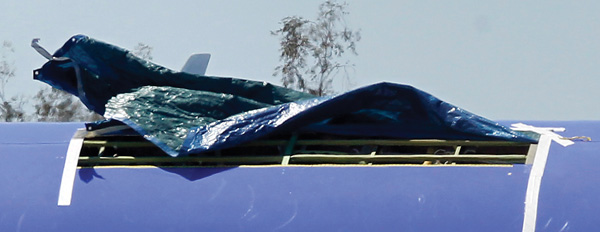Last year, a 5-foot hole ripped open in the roof of a Boeing 737 soon after takeoff. The plane landed safely with nobody hurt, but the incident caused the airline to ground all its aircraft for several days to inspect for stress cracks in the fuselages.
That’s a big, expensive task, and a tricky one to boot: As they age, all planes develop metal fatigue resulting in cracks, but not all cracks are dangerous. The problem is, how do you know which ones are? “A lot of inspections are visual: People look with their naked eyes, and that is not enough,” says Somnath Ghosh, the Whiting School’s inaugural Michael G. Callas Professor of Civil Engineering. “We need to be able to predict which cracks will grow to failure.”
That is exactly what Ghosh, who arrived at Hopkins in April 2011 as the director of the Computational Mechanics Research Laboratory, is doing. He and his dozen students and postdocs are working with the Air Force as well as the Federal Aviation Association (FAA), GE Aviation, and Pratt & Whitney to predict when and where dangerous cracks are likely to occur on existing planes and to guide the structural design of future planes.
It’s a huge job done at a microscopic scale: They study the behavior of the metals and composites at the level of the atom, and then they develop virtual computational models to determine what happens to the fuselage, the wing, engine blades and disks, and other components each time the plane flies.
Dennis Dimiduk, technical director of the Metals, Ceramics, and Nondestructive Evaluation Division at the Air Force Research Laboratory, turned to Ghosh and his lab for assistance in his research on the behavior of nickel alloys called superalloys, which are used in the hot section (combustion area) of jet engines. Metals consist of clustered crystals known as grains. It is fairly easy to discern the two-dimensional grain structure of these alloys, but Dimiduk needed to know the three-dimensional structure to better understand fatigue and fracture.

He says he couldn’t have done it without Ghosh’s help. With Ghosh, Dimiduk and his lab were able to develop a computational method to understand the structures in three dimensions and gain entirely new insights into how stresses between grains affect cracking predictions. “It seemed an insurmountable problem at first,” says Dimiduk, “but working with Somnath, we have widely opened the door on three-dimensional materials science and metallurgy.”
Ghosh’s research applies beyond aviation. To talk to Ghosh is to be struck by the range of his research projects, both in fundamentals and their practical applications. He and his lab are helping Ford and GM develop sounder engine bodies and automotive parts. They’re working with Los Alamos National Laboratory to study the materials in nuclear weaponry, and with the U.S. Army to develop armor that is more blast-resistant. They’re even working with drug delivery companies to help develop minuscule drug-containing capsules that could be navigated by electro-osmosis to control where the drug is delivered in the human body.
“Our work is a combination of computer science, mathematics, mechanics, physics, and visualization techniques that all come together in a simulation,” says Ghosh.
The research is so far-reaching that it was used to cement the new Mechanics of Materials program within the Department of Civil Engineering, according to Ben Schafer, the Swirnow Family Faculty Scholar and chair of Civil Engineering. “We were fortunate to find a high-energy individual who has performed groundbreaking research in the mechanics of materials and who thematically fit nearly perfectly with future goals for the department,” says Schafer.
Dimiduk concurs and adds: “When you work with him you know you will be pushed to the limits of your thinking. It’s very rewarding.”




